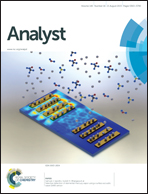An efficient ratiometric fluorescent probe for tracking dynamic changes in lysosomal pH†
Abstract
Lysosomes are acidic organelles (approximately pH 4.5–5.5) and tracking the changes in lysosomal pH is of great biological importance. To address this issue, quite a few of fluorescent probes have been developed. However, few of these probes can realize the tracking of dynamic changes in lysosomal pH. Herein, we report a new lysosome-targeted ratiometric fluorescent probe (FR-Lys) by hybridizing morpholine with a xanthane derivative and an o-hydroxy benzoxazole group. In this probe, the morpholine group serves as a targeting unit for lysosome, the xanthane derivative exhibits a pH-modulated open/close reaction of the spirocycle, while the o-hydroxy benzoxazole moiety shows a pH modulated excited-state intramolecular proton transfer (ESIPT) process. Such a design affords the probe a ratiometric fluorescence response towards pH with pH values ranging from 4.0 to 6.3. The response of the probe to pH was fast and reversible with high selectivity. Moreover, this probe possesses further advantages such as easy synthesis, high photostability and low cytotoxicity. These features are favorable for tracking dynamic pH changes in biosystems. It was then applied for dynamic imaging pH changes in lysosomes with satisfactory results.


 Please wait while we load your content...
Please wait while we load your content...